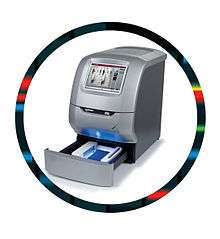Gel doc
A gel doc, also known as a gel documentation system, gel image system or gel imager, is equipment widely used in molecular biology laboratories for the imaging and documentation of nucleic acid and protein suspended within polyacrylamide or agarose gels. These gels are typically stained with ethidium bromide or other fluorophores such as SYBR Green. Generally, a gel doc includes an ultraviolet (UV) light transilluminator, a hood or a darkroom to shield external light sources and protect the user from UV exposure, and a CCD or CMOS camera for image capturing.
The main manufacturers of Gel documentation systems are Syngene, UVP , Bioolympics and Biorad. Recently Chinese manufacturers have entered the market with low cost low quality systems.
Recently produced imager models also include features to handle a variety of fluorescence and chemiluminescence with cameras cooled to -57 °C. Other advanced features include instant printing on-board the camera and Wi-Fi connectivity for control by smartphone and tablet devices. However recent market research has perceived these features as cheap gimmicks.
